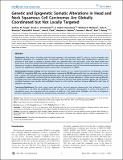| dc.contributor.author | Poage, Graham M. | |
| dc.contributor.author | Christensen, Brock C. | |
| dc.contributor.author | McClean, Michael D. | |
| dc.contributor.author | Wiencke, John K. | |
| dc.contributor.author | Posner, Marshall R. | |
| dc.contributor.author | Nelson, Heather H. | |
| dc.contributor.author | Marsit, Carmen J. | |
| dc.contributor.author | Kelsey, Karl T. | |
| dc.contributor.author | Hoheisel, Jörg | |
| dc.contributor.author | Houseman, Eugene Andres | |
| dc.contributor.author | Clark, John Ross | |
| dc.date.accessioned | 2010-11-12T14:10:33Z | |
| dc.date.issued | 2010 | |
| dc.identifier.citation | Poage, Graham M., Brock C. Christensen, E. Andres Houseman, Michael D. McClean, John K. Wiencke, Marshall R. Posner, John R. Clark, Heather H. Nelson, Carmen J. Marsit, and Karl T. Kelsey. 2010. Genetic and epigenetic somatic alterations in head and neck squamous cell carcinomas are globally coordinated but not locally targeted. PLoS ONE 5(3): e9651. | en_US |
| dc.identifier.issn | 1932-6203 | en_US |
| dc.identifier.uri | http://nrs.harvard.edu/urn-3:HUL.InstRepos:4553331 | |
| dc.description.abstract | Background: Solid tumors, including head and neck squamous cell carcinomas (HNSCC), arise as a result of genetic and epigenetic alterations in a sustained stress environment. Little work has been done that simultaneously examines the spectrum of both types of changes in human tumors on a genome-wide scale and results so far have been limited and mixed. Since it has been hypothesized that epigenetic alterations may act by providing the second carcinogenic hit in gene silencing, we sought to identify genome-wide DNA copy number alterations and CpG dinucleotide methylation events and examine the global/local relationships between these types of alterations in HNSCC. Methodology/Principal Findings: We have extended a prior analysis of 1,413 cancer-associated loci for epigenetic changes in HNSCC by integrating DNA copy number alterations, measured at 500,000 polymorphic loci, in a case series of 19 primary HNSCC tumors. We have previously demonstrated that local copy number does not bias methylation measurements in this array platform. Importantly, we found that the global pattern of copy number alterations in these tumors was significantly associated with tumor methylation profiles (p<0.002). However at the local level, gene promoter regions did not exhibit a correlation between copy number and methylation (lowest q = 0.3), and the spectrum of genes affected by each type of alteration was unique. Conclusion/Significance: This work, using a novel and robust statistical approach demonstrates that, although a “second hit” mechanism is not likely the predominant mode of action for epigenetic dysregulation in cancer, the patterns of methylation events are associated with the patterns of allele loss. Our work further highlights the utility of integrative genomics approaches in exploring the driving somatic alterations in solid tumors. | en_US |
| dc.language.iso | en_US | en_US |
| dc.publisher | Public Library of Science | en_US |
| dc.relation.isversionof | doi:10.1371/journal.pone.0009651 | en_US |
| dc.relation.hasversion | http://www.ncbi.nlm.nih.gov/pmc/articles/PMC2836370/pdf/ | en_US |
| dash.license | LAA | |
| dc.subject | genetics and genomics | en_US |
| dc.subject | cancer genetics | en_US |
| dc.subject | epigenetics | en_US |
| dc.subject | molecular biology | en_US |
| dc.subject | DNA methylation | en_US |
| dc.subject | otolaryngology | en_US |
| dc.subject | head and neck cancers | en_US |
| dc.title | Genetic and Epigenetic Somatic Alterations in Head and Neck Squamous Cell Carcinomas Are Globally Coordinated but Not Locally Targeted | en_US |
| dc.type | Journal Article | en_US |
| dc.description.version | Version of Record | en_US |
| dc.relation.journal | PLoS ONE | en_US |
| dash.depositing.author | Houseman, Eugene Andres | |
| dc.date.available | 2010-11-12T14:10:33Z | |
| dash.affiliation.other | SPH^Biostatistics | en_US |
| dc.identifier.doi | 10.1371/journal.pone.0009651 | * |
| dash.authorsordered | false | |
| dash.contributor.affiliated | Clark, John | |
| dash.contributor.affiliated | Houseman, Eugene Andres | |


